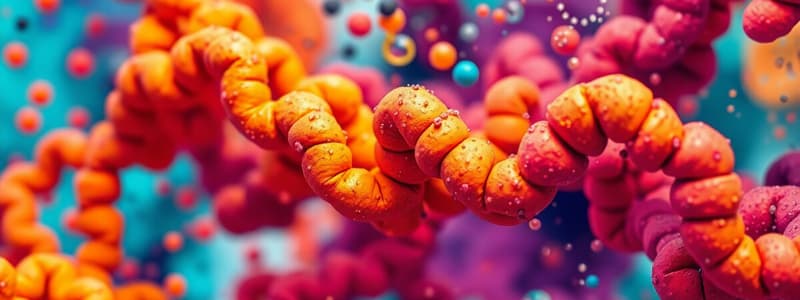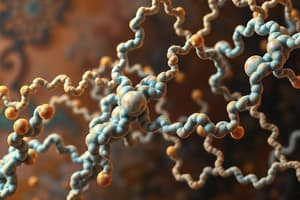Podcast
Questions and Answers
What role does phosphoanhydride bond play in cellular metabolism?
What role does phosphoanhydride bond play in cellular metabolism?
- It serves as a high-energy bond for ATP and GTP. (correct)
- It acts as a source of carbon in metabolic pathways.
- It helps in the stabilization of proteins.
- It provides phosphate groups for nucleotide synthesis.
Which of the following components is NOT involved in the citric acid cycle?
Which of the following components is NOT involved in the citric acid cycle?
- Glyceraldehyde 3-phosphate (correct)
- Oxaloacetate
- Acetyl-CoA
- Indole
What is a key product of the aldol cleavage described in the content?
What is a key product of the aldol cleavage described in the content?
- Citric acid
- Acetyl-CoA
- Glyceraldehyde 3-phosphate (correct)
- Indole-3-glycerol phosphate
Which enzyme is mentioned as being involved in producing indole based on the provided content?
Which enzyme is mentioned as being involved in producing indole based on the provided content?
What does the tunnel between the a and b subunits facilitate?
What does the tunnel between the a and b subunits facilitate?
Which protein is susceptible to allosteric regulation?
Which protein is susceptible to allosteric regulation?
What is the primary function of allosteric regulation in hemoglobin?
What is the primary function of allosteric regulation in hemoglobin?
What is the significance of the Hill Equation in the context of cooperative ligand binding?
What is the significance of the Hill Equation in the context of cooperative ligand binding?
Which of the following best illustrates an example of a defect in hemoglobin?
Which of the following best illustrates an example of a defect in hemoglobin?
How do oxygen-binding proteins like myoglobin and hemoglobin differ fundamentally in their function?
How do oxygen-binding proteins like myoglobin and hemoglobin differ fundamentally in their function?
What is the primary characteristic of allosteric proteins?
What is the primary characteristic of allosteric proteins?
Which of the following is NOT typically involved in the regulation of allosteric proteins?
Which of the following is NOT typically involved in the regulation of allosteric proteins?
What effect do allosteric activators have on enzyme activity?
What effect do allosteric activators have on enzyme activity?
Which model describes the behavior of allosteric proteins?
Which model describes the behavior of allosteric proteins?
How do allosteric transitions contribute to the regulation of metabolism?
How do allosteric transitions contribute to the regulation of metabolism?
In the allosteric model, what happens when an allosteric inhibitor binds to the enzyme?
In the allosteric model, what happens when an allosteric inhibitor binds to the enzyme?
Allosteric enzymes usually exhibit which kind of kinetics?
Allosteric enzymes usually exhibit which kind of kinetics?
Which structural feature is critical for allosteric modulation in proteins?
Which structural feature is critical for allosteric modulation in proteins?
What distinguishes allosteric regulation from classical competitive inhibition?
What distinguishes allosteric regulation from classical competitive inhibition?
Which of the following statements about allosteric enzymes is TRUE?
Which of the following statements about allosteric enzymes is TRUE?
Flashcards
Glycolysis
Glycolysis
A metabolic pathway that breaks down glucose into energy.
Citric Acid Cycle
Citric Acid Cycle
A series of chemical reactions that releases energy from food molecules.
Fatty Acid Oxidation
Fatty Acid Oxidation
The process of breaking down fatty acids for energy.
Indole-3-glycerol phosphate
Indole-3-glycerol phosphate
Signup and view all the flashcards
Aldol cleavage
Aldol cleavage
Signup and view all the flashcards
Myoglobin
Myoglobin
Signup and view all the flashcards
Hemoglobin
Hemoglobin
Signup and view all the flashcards
Cooperative Ligand Binding
Cooperative Ligand Binding
Signup and view all the flashcards
Hill Equation
Hill Equation
Signup and view all the flashcards
Allosteric Regulation
Allosteric Regulation
Signup and view all the flashcards
Immunoblotting
Immunoblotting
Signup and view all the flashcards
Henderson-Hasselbalch Equation
Henderson-Hasselbalch Equation
Signup and view all the flashcards
Michaelis-Menten Equation
Michaelis-Menten Equation
Signup and view all the flashcards
Competitive Inhibitor
Competitive Inhibitor
Signup and view all the flashcards
Uncompetitive Inhibitor
Uncompetitive Inhibitor
Signup and view all the flashcards
Mixed Inhibitor
Mixed Inhibitor
Signup and view all the flashcards
SDS Gel Electrophoresis
SDS Gel Electrophoresis
Signup and view all the flashcards
Primary Protein Structure
Primary Protein Structure
Signup and view all the flashcards
Tertiary Protein Structure
Tertiary Protein Structure
Signup and view all the flashcards
Quaternary Protein Structure
Quaternary Protein Structure
Signup and view all the flashcards
Dideoxy Sequencing
Dideoxy Sequencing
Signup and view all the flashcards
Plasmid Cloning
Plasmid Cloning
Signup and view all the flashcards
Polymerase Chain Reaction (PCR)
Polymerase Chain Reaction (PCR)
Signup and view all the flashcards
Free-Energy Change for Transport
Free-Energy Change for Transport
Signup and view all the flashcards
Bioenergetics
Bioenergetics
Signup and view all the flashcards
Study Notes
Chapter Organization and Resources
- The textbook, Lehninger Principles of Biochemistry, Sixth Edition, includes various media resources on the Instructor's CD-ROM and website (www.courses.bfwpub.com/lehninger6e).
- It contains mechanism animations (12 total), technique animations (10 total), living graphs (15 total), and molecular structure tutorials (9 total).
- Mechanism animations detail specific biochemical reactions.
- Technique animations demonstrate research methods.
- Living graphs allow manipulation of parameters and visualization of results.
- Molecular structure tutorials support comprehension using 3D molecular models.
- New animations will be added throughout the edition's lifespan.
Specific Chapter Content
- Chapter 2: Water
- Chapter 3: Amino Acids, Peptides, and Proteins (including molecular structure tutorials on protein architecture—amino acids, sequence and primary structure, α helix, β sheet, turn, introduction to tertiary structure, tertiary structure of fibrous proteins, tertiary structure of small globular proteins, tertiary structure of large globular proteins, and quaternary structure)
- Chapter 5: Protein Function (includes molecular structure tutorials on oxygen-binding proteins—Myoglobin, hemoglobin, and hemoglobin susceptibility to allosteric regulation, and MHC molecules; Living Graphs on protein-ligand interactions, binding curve for myoglobin, cooperative ligand binding, and Hill equation)
- Chapter 6: Enzymes (containing Living Graphs related to the Michaelis-Menten equation, competitive inhibitors, uncompetitive inhibitors, mixed inhibitors, and Lineweaver-Burk equation; and a mechanism animation for chymotrypsin)
- Chapter 8: Nucleotides and Nucleic Acids (includes a molecular structure tutorial on building blocks of nucleic acids)
- Chapter 9: DNA-Based Information Technologies (includes technique animations for plasmid cloning, reporter constructs, and polymerase chain reaction)
- Chapter 11: Biological Membranes and Transport (includes living graphs concerning free-energy change for transport and free-energy change for transport of ions; and a molecular structure tutorial on bacteriorhodopsin)
- Chapter 12: Biosignaling (includes a molecular structure tutorial on trimeric G proteins)
- Chapter 13: Bioenergetics and Biochemical Reaction Types (includes living graphs on free-energy change and free-energy of hydrolysis of ATP)
- Chapter 14: Glycolysis, Gluconeogenesis, and the Pentose Phosphate Pathway (includes mechanism animations for phosphohexose isomerase, alcohol dehydrogenase, and thiamine pyrophosphate mechanisms)
- Chapter 16: The Citric Acid Cycle (includes a mechanism animation for citrate synthase)
- Chapter 17: Fatty Acid Catabolism (includes a mechanism animation for fatty acyl-CoA synthetase)
- Chapter 18: Amino Acid Oxidation and the Production of Urea (includes mechanism animations for pyridoxal phosphate reactions)
- Chapter 19: Oxidative Phosphorylation and Photophosphorylation (includes a living graph for free-energy change for transport of an ion)
- Chapter 20: Carbohydrate Biosynthesis in Plants and Bacteria (includes a mechanism animation for Rubisco)
- Chapter 22: Biosynthesis of Amino Acids, Nucleotides, and Related Molecules (includes mechanism animations for tryptophan synthase and thymidylate synthase)
- Chapter 24: Genes and Chromosomes (includes an animation on three-dimensional packaging of nuclear chromosomes)
- Chapter 25: DNA Metabolism (includes molecular structure tutorials on restriction endonucleases, animation on nucleotide polymerization by DNA polymerase, and DNA synthesis)
- Chapter 26: RNA Metabolism (includes an animation on mRNA splicing and a molecular structure tutorial on hammerhead ribozyme; and an animation on the life cycle of an mRNA)
- Chapter 28: Regulation of Gene Expression (includes a molecular structure tutorial on the lac repressor)
- Techniques: Immunoblotting, SDS Gel Electrophoresis, Dideoxy Sequencing of DNA.
Studying That Suits You
Use AI to generate personalized quizzes and flashcards to suit your learning preferences.
Related Documents
Description
Explore key concepts from Chapters 2 and 3 of the Lehninger Principles of Biochemistry, focusing on water's properties and the structure of amino acids and proteins. This quiz assesses your understanding of biochemical reactions, molecular structures, and related techniques using interactive animations and tutorials.



